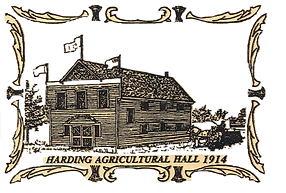HARDING FAIR
Harding, Manitoba
Friday July 18, 2025

Have you ever been to Harding Fair?
If you have you will understand what I am talking about; if not it is "a must" for your bucket list". As an exhibitor you will appreciate the depth of quality of our exhibits as you can see by our array of pictures. As a spectator it is an exquisite showcase of "rural living" on display!
Knowing a little bit of history always adds to the enjoyment, I think. The following is taken from the Harding history books, Home to Harding 1879-1981, and Home to Harding 2nd edition. This is a fair with a great history, that has continued relatively unchanged to this day.
The "first" Harding Fair was held in October, 1904 in W. H. English's pasture, just north of the railroad tracks. Tom Hammond of Tarbolton district remembers the first fair. One highlight,for him, was the horse-pull competition which used a stone-boat loaded with stones: cattle and horses were shown, ribbons handed out and the ice cream "made on the spot" in the old ice-cream freezers. The competitors were from close at hand, which was measured by the distance the stock could be driven in one day. The livestock were tied to trees and wagons during the fair until the present day fairgrounds were purchased from Frank English in 1914 and barns were built. The first barn, built in 1916, served as a rink in the winter with one sheet of curling ice in the middle and skating ice around the outside.
The Agricultural Hall was built in 1914. Women's exhibits were upstairs: vegetables and grains were downstairs. Dances were held upstairs.
In 1919 a standing wheat competition and a summerfallow competion was introduced. The fair was moved to July and was to be "either Tuesday or Friday" because of the train services for the judges and competitors.
Harding fair was declared a Class B fair in 1923. By 1926, it was declared the "top stock fair" out of 83 Ag societies with a total of 321 horse entries and 352 cattle.
The Depression took its toll. There was no fair from 1931-1936 but the Ag society remained active and sponsored colt sales.
The fairs resumed in 1936. To get government grants it was now necessary to have additional events happening so a Boar Club was established. This later developed into the Boys and Girls Swine Club.
As local 4-H clubs organized there was lots of participation and competion between members as well as between clubs. Harding had a 4-H clothing club called the " Harding Happy Hemmers" (1955-1966).
4-H calf clubs from Harding (1946), Kenton and Lenore held their local acheivements and an interclub show.
All Manitoba fairs were affected in 1952 by an outbreak of hoof and mouth disease in the Regina area. All cloven-hoofed animals were barred from the fairs.
Through out the years there has continued to be additons and deletions of events such as dairy cattle, chickens, rabbits, swine, ball games, tractor pulls, antique machinery displays, King farmer competitions. Harding and Kenton 4-H clubs disbanded due to lack of children as a result the 4-H show was replaced by a jackpot heifer class and provincial summer cattle shows.
The board has continually worked to maintain the existing buildings and to replace if necessary and/or add additional barns. A new barn was built a few years ago for the heavy horses and this year the light horses have a new barn. A gorgeous outdoor riding area was developed for our barrel racing and pole bending competitions andsome of the light horse classes.
The home living exhibits are displayed in a separate building adjacent to the Agricultural Hall and the sewing is beautifully displayed in the lower level of the Agricultural Hall. Handicraft and schoolwork can be seen in the upstairs of the Agricultural Hall. The main office is located downstairs. The meals for the day; begin with a complimentary Pancake breakfast and cold plate meals served at noon and supper by the Harding Community Club in the Community Centre.
Our fair has always met with positive media reports. It has been described as "The Royal Fair", "The Harding State Fair, "the best little fair around". I think F.A Rosser in his Brandon Sun Article in 1980 has truly grasped the essence of Harding fair as he writes, "Several times at the Ag Centre (Brandon) I've heard reference to Harding Fair; it is viewed as an example of the Prairie spirit. I now know why.
Harding is a small community with a great reputation. The population is around 30, but they put on one of Manitoba's best country fairs. Harding's reputation as a fair is based on purity of purpose; it exists as an agricultural show serving area farmers, nothing more. For that reason it has stayed away from spectator sports such as baseball tournaments. It is a triumph of co-operation. Volunteers cheerfully working at helping the community--that's what puts the fibre in our social structure. Harding Fair is a great example."
The late Grant Moffat, in his 2005 article for the Farmer's Independent Weekly , identified Harding as having a population of 10, including the dogs. He, too, comments on the volunteers working together as the basis of the success that Harding fair has enjoyed throughout the years and continues to enjoy today.
We couldn"t agree more. I hope this bit of history has wet your enthusiasm to compete and/or visit our fair. We look forward to meeting you at ringside!